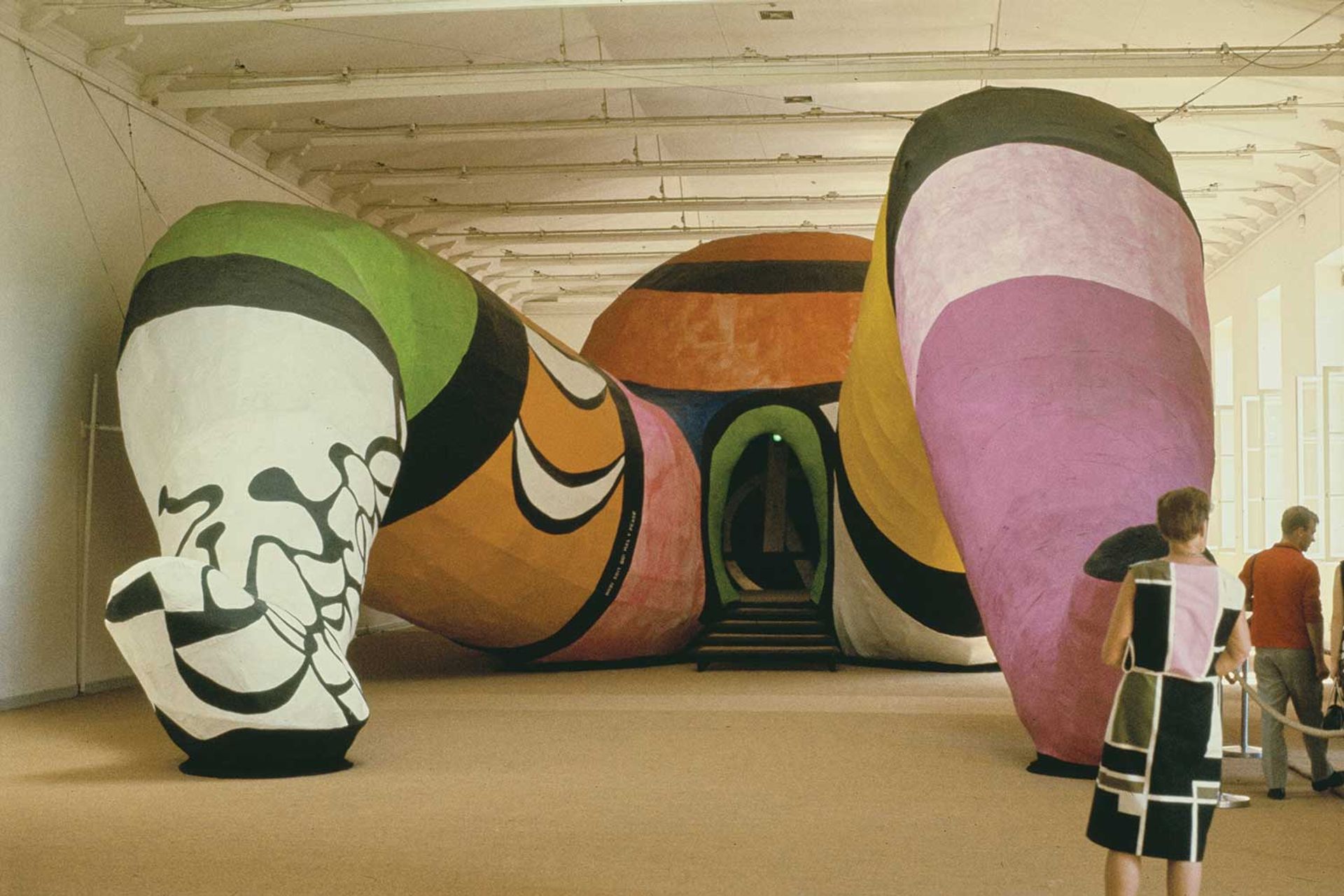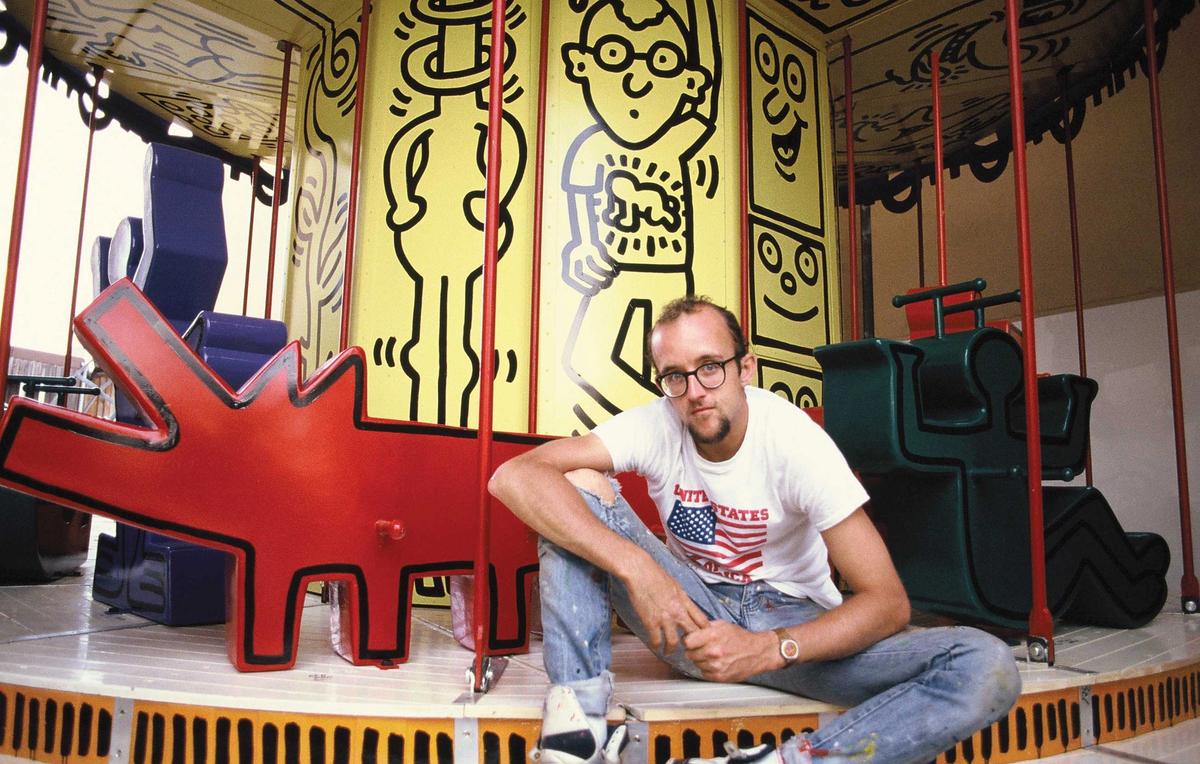With a colourful carousel by Keith Haring and Ferris wheel by Jean-Michel Basquiat, the art carnival known as Luna Luna was a big crowd-pleaser in Hamburg, Germany the summer of 1987. Now, after a cultural production team led by Drake rescued the rides from decades-long storage, it’s become a hot ticket in Los Angeles.
Even though visitors today can’t actually go on the rides, tickets to Luna Luna in its new incarnation in a downtown Los Angeles warehouse have been selling for $30 and upwards, or as much as $85 for a “moon pass” that includes parking and entry to Salvador Dalí’s hall of mirrors and David Hockney’s stage-set-like forest pavilion. And its flashy, carnival-barker-style website trumpets Luna Luna as “the world’s first and only art amusement park”. Next up, Drake’s group plans to commission contemporary artists to create working rides that could tour internationally—the original goal of Luna Luna’s founder, the Austrian artist-musician-impresario André Heller.
The Hamburg art park does prove wildly original in some ways. Where else could you find a jazzy Basquiat Ferris wheel spinning to the tune of Miles Davis’s Tutu, boldly coloured archways by Sonia Delaunay modelled on the Arc de Triomphe, and a “fart orchestra” created by the German artist Manfred Deix? (Deix’s symphony is quite possibly the first of its kind, and very hopefully the last.)
But Luna Luna isn’t entirely sui generis; you can find plenty of recent examples of immersive or interactive pop-culture experiences designed by artists, whether Banksy’s dystopian pop-up theme park Dismaland in Somerset in 2015 or the labyrinth of Meow Wolf in Santa Fe, with its spinoffs in Las Vegas, Denver and Houston. There are historic examples, too, as modern ideas of the circus, funhouse and haunted house (also zoos and menageries) evolved almost simultaneously with the rise of the fine art museum. A range of artists have found ways to play with those experiences—as seen in these five precedents for the creative lunacy that is Luna Luna.
Alexander Calder’s circus in Paris and New York (1926-31)
Sure, the Cirque Calder is miniature, but it had a big impact on almost everyone lucky enough to see it in action in the 1920s, and arguably inspired Marcel Duchamp, who liked watching Calder unpack the travelling carnival from his suitcases, to create his own mini-museum or boîte-en-valise. The idea came to Calder in 1926, the year after he spent two weeks at the Ringling Bros and Barnum and Bailey circus on assignment as an illustrator for the National Police Gazette. He soon devised out of wire, clothespins, corks, cranks, gears and more an entire circus-worth of characters that he could mechanically set into motion, from a clown that blows up a balloon to elephants with swinging trunks and trapeze artists that lurch through the air. These days, in the Whitney Museum of American Art’s permanent collection, the inanimate circus performers and animals might look a lot like sculptures, but they’re also the props and personas of an artist who doubled as ringmaster.
Salvador Dalí’s Dream of Venus pavilion at the World’s Fair in New York (1939)
Dalí’s showstopper for the 1938 International Surrealist Exhibition in Paris, where he sent live snails crawling on the bare skin of a female mannequin in a flooded taxicab, was just a teaser for what he produced the following year at the New York World’s Fair: an oversexed funhouse, or hyper-aesthetic peephouse. Along with a new version of his so-called Rainy Taxi, his Dream of Venus pavilion featured an enormous sculpture of the goddess reclining in a 36 ft chaise with half-naked showgirls performing in pools beside her. The outside of the building looked like a baroque castle that had been chewed up by rodents. Now, it gets credit as one of the first examples of installation art; at the time it belonged to “The Amusement Zone”, the area of the fair outside the official government and corporate contributions. As the editors of Open Culture recently noted: “Whatever organisers of the 1939 New York World’s Fair thought they might get when Salvador Dalí was chosen to design a pavilion, they got a Coney Island of the Surrealist mind.”
Walter Hopps’s Merry-Go-Round Show at the Santa Monica Pier (1955)
While Heller’s vision for Luna Luna was deeply rooted in boyhood visits to the carnival, the curator Walter Hopps’s original idea for siting Action 1, his ambitious survey of California Expressionist painting, was more flexible. First, Hopps thought to take over a supermarket on Sunset Boulevard, then he tried to line up Frank Lloyd Wright’s Hollyhock House in Barnsdall Park, which belongs to the city of Los Angeles. But he couldn’t secure either site, so he ended up renting the carousel hall at the Santa Monica Pier, home to an old-timey amusement park. There, he hung paintings on the walls by artists such as Mark Rothko, Clyfford Still, Jay DeFeo and Richard Diebenkorn. One sad fact: the painted ponies did not go up and down, as apparently Hopps put a tarp over the carousel to prevent them from competing with the fine art. But the show still did phenomenally well at the box office, drawing Allen Ginsberg, Jack Kerouac and art critics Hopps had never met as well as a tourist-type crowd. “It attracted the most totally inclusive mix of people—mom, dad and the kids, and Neal Cassady and other strange characters,” Hopps once told Hans Ulrich Obrist: another art-world populist.
Niki de Saint Phalle’s Hon—en katedral (She—a Cathedral) at the Moderna Museet in Stockholm (1966)
Created by De Saint Phalle and her partner, Jean Tinguely, Hon was an amusement park that took the form of an enormous fertility goddess, using the same sort of rotund, cartoonish imagery familiar today from her Nana sculptures. The artist built this female form within the Moderna Museet to the height of a two-storey building, so that people could enter an opening between her bulging, brightly painted legs to explore her various cavities. Once inside the body, visitors found a miniature art gallery, a planetarium, an aquarium, a film-screening room and a milk bar (inside a breast, of course), with a malfunctioning brain made by Tinguely. The goddess’s right leg had a parquet-covered slide for kids, bringing elements of the playground into the museum in much the same way that Pop art injected everyday items and imagery into the high-art context.

Womb with a view: Niki de Saint Phalle’s 1966 work Hon—en Katedral, at Stockholm’s Moderna Museet, included a miniature art gallery, planetarium, aquarium, a milk bar and a children’s slide
Photo: Gai Terrell/Redferns/Getty Images
Womanhouse in Los Angeles (1972)
More haunted house than funhouse, Womanhouse was a month-long, walk-in exhibition inside an abandoned home in Los Angeles featuring visions of women trapped by domesticity. Sculptures of breasts and fried eggs by Vicki Hodgetts crowded the kitchen walls. A mannequin was wedged inside a linen closet by Sandra Orgel, her body bisected by the shelves like a housewife trapped by so many loads of washing and ironing. In a bathroom by Judy Chicago, bloody tampons littered the floor like bodies on a battlefield. The house was the work of Chicago, Miriam Schapiro and their students in the Feminist Art Program at CalArts. At a time when they didn’t have a classroom (or campus), Chicago and Schapiro transformed a dilapidated house in Hollywood into their school, studio and boundary-breaking exhibition space. One of the most influential pieces was also one of the most interactive: inspired by brush huts she saw and made growing up in Paraguay, Faith Wilding created a “crocheted environment” in a small, dark room that people could enter. Menacing and inviting both, it offered a counterpoint to the joy rides of typical amusement parks: a place where you could sit, contemplate and meditate. It became known as the “womb room”.


